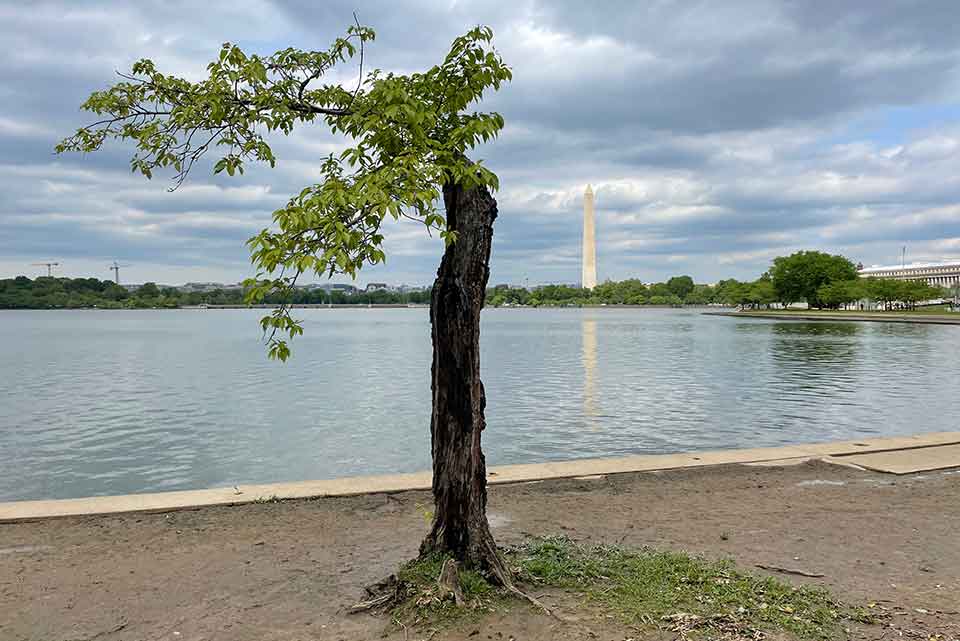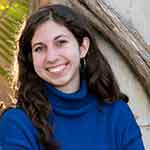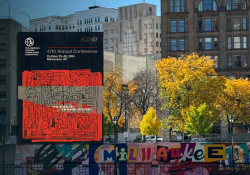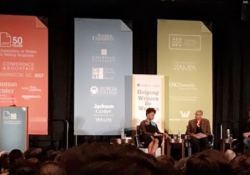Takeaways from GWU’s Inaugural Student Journal Symposium

Reflecting on their trip to attend a conference dedicated to literary and research publications, two University of Oklahoma student editors share insights learned and inspirations for the future.
Rachel Smith
“Please be aware that First Amendment activity is occurring on the George Washington University Foggy Bottom Campus today. The Symposium will be held as scheduled. The First Amendment activity should not affect the Symposium,” the email in my inbox read. I puzzled for a moment until it dawned on me that “First Amendment activity” was just a very “DC” way of referring to the national rise in student protests and demonstrations pertaining to the ongoing war and humanitarian crisis in Gaza. Less than a block away from GWU’s Gelman Library, where the inaugural student journal symposium I was set to attend was to be held, University Yard was evolving into a significant site of protest against the war with students setting up encampments to demonstrate their solidarity. From this matter-of-fact update in my inbox to the unapologetically worn and well-trodden grounds in front of the Capitol building I’d noticed the day before, the way this “First Amendment activity” was made to feel like the norm here made me marvel at this city, the raw power of the people’s voice, and the US Constitutional amendments perhaps about to play out before my very eyes. Here, in Washington, DC, I was at the epicenter of American politics, hyperreal and electric, which I found both thrilling and daunting as I vertiginously perceived that I, too, was a small part of the mechanism at work. After all, “First Amendment activity” could be equally applied, I speculated, with a little less gravity, to the very symposium for student research and literary publications I would be attending that afternoon on the same campus.
“I was at the epicenter of American politics, hyperreal and electric, which I found both thrilling and daunting as I vertiginously perceived that I, too, was a small part of the mechanism at work.”—Rachel Smith
The fact was, my co-editor, Maddie, and I were in DC on a mission to make student voices heard as well. With the support of our advisers at World Literature Today, we quickly found ourselves booking hotels, prepping notes, and stuffing suitcases, excited for a rather impromptu opportunity to attend George Washington University’s inaugural DMV Student Journal Symposium for Literary and Research Publications on behalf of The Aster Review, the University of Oklahoma’s student arts and literary journal. The symposium website stated its chief aims were “to foster conversation on best editorial, leadership, and community practices and discover how to support student publications,” and we eagerly looked forward to learning all of the above from both professionals in publishing and other participating graduate and undergraduate journals much like our own.
Publishing, as a profession, had always seemed slightly mystifying to me and out of reach, certainly above entry-level, so I could not have anticipated how much I would learn from or enjoy listening to the industry knowledge of the plenary panelists: Kelly Squazzo, director of library and publisher partnerships at Johns Hopkins University Press’s Project MUSE, and Swapna Padhye, publishing director of humanities, social science, and law journals at Oxford University Press as well as that of moderator John W. Warren, director of the GW Graduate Program in Publishing and symposium organizer. My mystification, however, was somewhat warranted as I learned that publishing touches on virtually every sector and includes roles in everything from acquisitions and marketing to design and finance, research, public relations, digital humanities, and more. Additionally, there are publishing needs in nearly every area of interest and for every type of media. For this reason, Padhye said it was called “the accidental profession” while also emphasizing that its variety suited as many personality types and preferences regarding work/life balance.
Likewise, there are many pathways to becoming an editor. Soft skills, time management, and critical thinking, however, are indispensable skills to possess since, as Padhye points out, “You’re not working in a silo, you’re working cross-functionally,” maintaining contact points with everyone on a given project. A degree in English, she adds, “transfers beautifully.”
Discussing the impact of journal publications, Squazzo and Padhye shed crucial light on the relationship between publishers, journals, and audiences as well as the myriad new complexities technology has introduced to the industry. While technology has allowed for better discovery systems, novel means of engagement, open access, and plagiarism detection, there is still skepticism, especially around AI, with many believing it cannot ever truly be a substitute for scholarly peer review or trusted to ensure diversity, equity, and inclusion (DEI) as it has often been shown to reinforce bias rather than eliminate it. Recent progress in DEI within publishing has been attributed less to AI, then, and more to the Covid/hybrid model reaching more varied geographies. Additionally, there are some editors, particularly those of literary journals, who still prefer print to digital as a rule, while many STEM journals favor being digital so they can better track viewership. I imagine a reader in the future perusing a digital book thinking how wonderful it would be to hold a singular private object containing the same text in their hands, untethered to a screen, its data incorruptible and extant without battery life or Wi-Fi … but with open models trending in much-needed support of interdisciplinary researchers and the competitive edge that user data offers, a future return to print journals may remain a literary editor’s dream. Publishers must know the audience of the journal to know if there is a market that will ensure more revenue than the journal costs to publish, and digital is more cost-effective as well as sustainable. As a student panelist would later add, “Sustainability is business but also environmental justice.”
Both publishers and editors, then, have an invisible power to shape entire fields of research by supporting or sunsetting journals within a publishing house and accepting or rejecting research for those journals, respectively. Digital media and other technologies can be employed to provide open and instantaneous access through economy of scale, or deter and discourage the reading public with biased algorithms and overburdensome paywalls. This is the freedom of the press.
* * *
Madeline Meyers
From my seat next to Rachel, I paused my notetaking, gathering my thoughts in preparation for my most anticipated part of the symposium: the student panels. As the soon-to-be editor-in-chief of The Aster Review, the University of Oklahoma’s own undergraduate literature and arts journal, I was counting on these panels to give me the knowledge I needed to ensure the magazine lasted for another year.
The first group of panelists consisted of the editorial staff of Howard University’s The Amistad, The George Washington University Undergraduate Review, and American University’s AmLit. The second featured students from GWU’s The Globe and The George Washington University Undergraduate Law Review, University of Maryland’s The Catalyst, and American University’s Kogod Sustainability Review. As the panelists spoke about their success stories, the slideshow on display behind them began to cycle through the different journals’ covers. The designs were eye-catching and professional. Some, like The Amistad and AmLit, featured stylized artwork, while others, including GWU’s journals, had striking photos of campus or engaging graphics. Regardless of the style, each cover showcased a distinctive brand with intentional typography and design that drew me in. I forced my attention back to the panelists. I needed to absorb as much of their advice as I could. Would The Aster ever be that polished?
As I expected, the panelists’ experiences impressed me. The Amistad panelists, who wore matching shirts featuring their journal’s logo, described visiting other conferences to distribute their magazine and merchandise. Students from The Catalyst and GWU’s Undergraduate Law Review shared their tips for navigating the unique specifications of their fields. They spoke with well-earned confidence, and I was struck by how badly I wanted that level of self-assurance. But as the panels progressed, I began to hear not only a series of success stories, but also the challenges that accompanied them. The same Amistad staff that got to travel with their journal also faced high turnover rates from students graduating. Students from the Kogod Sustainability Review described the difficulties of rebuilding their journal after a years-long hiatus. And panelists from each publication acknowledged the difficulty of publishing work as well as how worthwhile that work is. Their confidence came from a place of humbleness and gratitude that I found shockingly relatable.
“Panelists from each publication acknowledged the difficulty of publishing work as well as how worthwhile that work is. Their confidence came from a place of humbleness and gratitude that I found shockingly relatable.”—Madeline Meyers
The last four years have presented many challenges for The Aster. Most of our experienced editorial staff graduated, and we lost two years’ worth of issues to Covid, leading to decreased student involvement and a significant loss of knowledge and momentum. As the rising editor-in-chief, I thought those were flaws unique to our journal that I would need to fix if I didn’t want to fail in my new role. But as I listened to the stories of my fellow student editors, I realized that the problems I will face are far bigger than just The Aster, and so are the solutions. Every student publication represented at the symposium has dealt with the impacts of Covid. They’ve all endured, maybe going on hiatus, but ready for a new class to take on the work. Plague years or not, student publications typically face rapid turnover as students graduate, so succession and the passing down of knowledge are not new problems. Now that I understand how common these issues are, I also understand that solving them is not something I can or should do on my own. Instead, I can learn from those who have gone before and use resources like this symposium to better equip The Aster for these challenges.
With my mind and notebook alike brimming with ideas, I said my goodbyes and packed up my conference swag, piling Project Muse sticky notes into my bag. As Rachel and I walked out of Gelman Library, we heard someone singing. Continuing toward Duke’s Grocery, a local restaurant where we planned to meet some of the speakers and other attendees for a postevent social, we caught a glimpse of the peaceful protest underway in the University Yard, where students were using signs, flags, and even music to show solidarity with Palestine. Here, too, were students trying to solve problems and make their voices heard.
As undergraduate students, we are eager to gain experience and leave our mark on the publishing world. We have the passion and skill to produce literary and research publications; we don’t always have the resources. The 2024 symposium was part of an effort to connect students and our faculty advisors with the resources we lack and expand our vision of how much we can accomplish. I hope to see this event and more like it continue and grow to keep up with students’ needs.
* * *
Rachel Smith
“Passion is contagious,” I scrawled into my complimentary GW notebook, my last takeaway quote from the student panels before packing up for the informal social hour at Duke’s Grocery nearby, the last and, by now, much-anticipated event on the itinerary. As Maddie and I walked down H Street in the warm afternoon breeze of late April, white azaleas, lush palatial greens, and cool shadows lining the busy sidewalks, we began to overhear bright notes of chanting, clapping, and singing from up ahead. We had found it, or it had found us, the protests at University Yard. The confident chanting, soft singing, nonchalance of respectful passersby, and, if you listened, a peaceful silence grounding it all, told me that not only was this part of the norm here, but this was sacred. As we drew closer, we saw media interviews, megaphones, and hand-made signs calling for peace. In the middle, students were sitting down in the road, many wearing a black-and-white Palestinian keffiyeh, if not making their voices heard, making their solidarity known, making felt the gravity around them of things happening halfway across the world. If not making progress today, making the news that others all across the country would watch, dismiss, debate, maybe emulate in their own cities, on their own campuses, and perhaps make tomorrow. Why do we wait? Why do we ask permission when we have the right?
“The confident chanting, soft singing, nonchalance of respectful passersby, and, if you listened, a peaceful silence grounding it all, told me that not only was this part of the norm here, but this was sacred.”—Rachel Smith
Pondering over this demonstration later, I realized both that I never would have experienced the poetry of the students’ spoken words in protest and written words in publication echoing and reflecting each other had I not been there, but also, that to make voices heard, I didn’t have to be. As publishers and editors we hold the megaphones, the microphones, the iPhones, so to speak, for those who want to share their voices. We are all part of the same process. If students can lead demonstrations, why not in publishing as well? The “student” in Student Journal Symposium, then, should not be a delimiter to the type of journal it can be, material it can publish, or level of success it can have, but if anything, signify a space from which to lead by example, to experiment, to try, fail, and succeed, a sacred space as well, worthy of supporting, protecting, embodying. Seeing that space carved for us in DC through GW’s Student Journal Symposium, we left less afraid to carve it out for ourselves and for others, too.
University of Oklahoma
Authors’ note: We would like to thank World Literature Today and the Department of English for sponsoring our trip.










